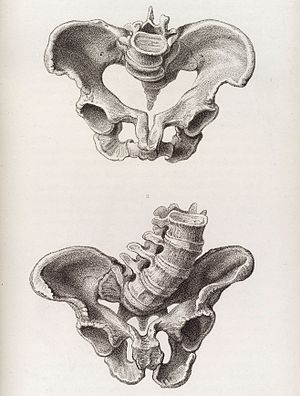Obstructed labor
| Obstructed labour | |
|---|---|
| Synonyms | Labour dystocia |
 |
|
| An image of a deformed pelvis, a risk factor for obstructed labour | |
| Specialty | Obstetrics |
| Complications | Perinatal asphyxia, uterine rupture, post-partum bleeding, postpartum infection |
| Causes | Large or abnormally positioned baby, small pelvis, problems with the birth canal |
| Risk factors | , malnutrition, vitamin D deficiency |
| Diagnostic method | Active phase of labour > 12 hours |
| Treatment | Cesarean section, vacuum extraction with possible surgical opening of the symphysis pubis |
| Frequency | 6.5 million (2015) |
| Deaths | 23,100 (2015) |
| Classification | |
|---|---|
| External resources |
Obstructed labour, also known as labour dystocia, is when, even though the uterus is contracting normally, the baby does not exit the pelvis during childbirth due to being physically blocked. Complications for the baby include not getting enough oxygen which may result in death. It increases the risk of the mother getting an infection, having uterine rupture, or having post-partum bleeding. Long term complications for the mother include obstetrical fistula. Obstructed labour is said to result in prolonged labour, when the active phase of labour is longer than twelve hours.
The main causes of obstructed labour include: a large or abnormally positioned baby, a small pelvis, and problems with the birth canal. Abnormal positioning includes where the anterior shoulder does not pass easily below the pubic bone. Risk factors for a small pelvis include malnutrition and a lack of exposure to sunlight causing vitamin D deficiency. It is also more common in adolescence as the pelvis may not have finished growing. Problems with the birth canal include a narrow vagina and perineum which may be due to female genital mutilation or tumors. A partograph is often used to track labour progression and diagnose problems. This combined with physical examination may identify obstructed labour.
The treatment of obstructed labour may require cesarean section or vacuum extraction with possible surgical opening of the symphysis pubis. Other measures include: keeping the women hydrated and antibiotics if the membranes have been ruptured for more than 18 hours. In Africa and Asia obstructed labor affects between two and five percent of deliveries. In 2015 about 6.5 million cases of obstructed labour or uterine rupture occurred. This resulted in 23,000 deaths down from 29,000 deaths in 1990 (about 8% of all deaths related to pregnancy). Most deaths due to this condition occur in the developing world.
...
Wikipedia
